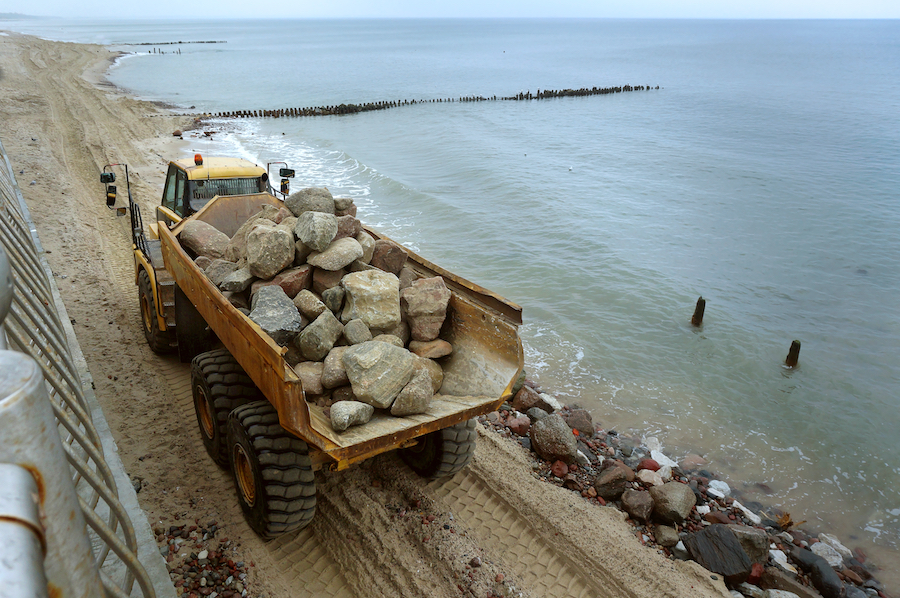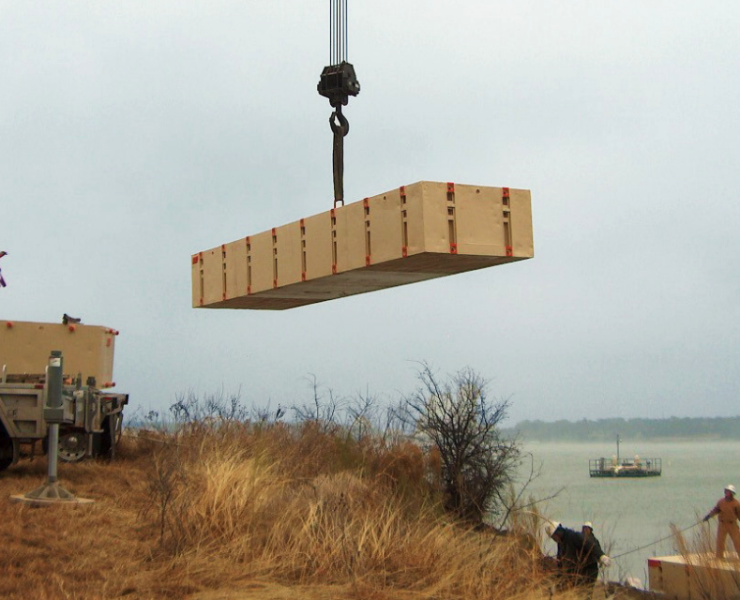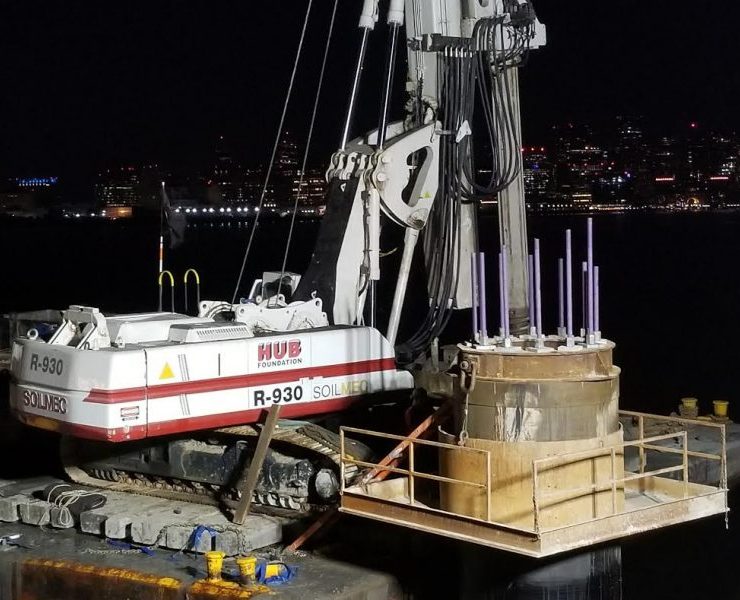Coastal Foundations Part II – The Problem with Closed Foundations in Coastal Construction


View Part I of this article here.
In the first part of our series on coastal foundations we discussed the challenges of building in a coastal area. In this article we review closed foundations and why they are not recommended for coastal structures.
Closed Foundations
Foundations consisting of solid perimeter walls are referred to as “closed.” Types of closed foundations include slab-on-grade (also called monolithic), closed-wall crawlspace, and stem wall.
Flood Performance
A closed foundation is not constructed to allow floodwaters to readily pass through. This design is particularly susceptible to breaking waves and other flood forces. This is why the National Flood Insurance Program (NFIP) prohibits closed foundations in V Zones. They are not recommended in Coastal A Zones, but probably should not be considered at all.
Limitations
Well-designed closed foundations are suitable in Special Flood Hazard Areas (SFHAs) where breaking waves are 1.5 feet high or less. (Except SFHAs where they are specifically prohibited.) The foundation walls must have openings that allow floodwater to enter the interior area. This keeps the load balanced by allowing the water surrounding the foundation to pass through. This greatly reduces lateral hydrostatic forces on the walls. Of course, the foundation must still handle the load of the structure itself. Refer to FEMA NFIP Technical Bulletin 1: Openings in Foundation Walls and Walls of Enclosures for more information. to learn more about how to properly design and construct foundations in SFHAs.
Design Concerns
Keep in mind that the reinforcement required to handle a 1.5 breaking wave is similar to that required for 120 mph winds. Taller foundation walls will also need more reinforcement to handle breaking wave loads. For example, the use of steel within masonry walls with a spacing of 16 inches on center. Refer to FEMA 550 for closed foundation designs built to resist wind loads and 1.5-foot-high breaking waves.
Types of Closed Foundations
Slab-on-Grade Foundations
Slab-on-grade foundations do not really have a perimeter foundation wall. Thickened parts of the slab are more like footers for interior and exterior bearing walls. This type of foundation is not cost-effective for in SFHAs that require a building to be elevated greater than one foot. This would require a lot more concrete. However, this type of foundation, where not prohibited, may be appropriate where compacted fill is used.
Parking
Parking is often placed under elevated buildings. It is recommended that they be designed to break away (frangible). Also, they should be constructed as self-supporting structures designed to handle flood conditions as well as anticipated erosion. Refer to the following NFIP technical bulletins for more information:
- TB5: Free of Obstruction Requirements for Buildings Located in Coastal High Hazard Areas.
- TB6: Below-Grade Parking Requirements.
Closed-Wall Crawlspace Foundations
Closed-wall crawlspace foundations consist of an elevated floor framing system supported by interior beams and piers. The interior area created by the foundation is often used for mechanical equipment. This requires additional precautions to maintain NFIP compliance.
A closed-wall crawlspace foundation is built upon fairly shallow, cast-in-place concrete footings. The depth of the footing is based upon the local frost depth. It is this shallowness that makes it susceptible to erosion and scour. They are not designed to handle breaking waves. For this reason, the NFIP prohibits closed-wall crawlspace foundations in V Zones and does not recommend their use in Coastal A Zones.
The NFIP requires that a closed-wall crawlspace foundation in an SFHA have at least two flood openings. The bottoms of the flood openings must be placed within one foot of grade to limit lateral forces on the foundation walls. (You can find more detailed information in FEMA’s Technical Bulletin 11: Crawlspace Construction for Buildings Located in Special Flood Hazard Areas.
Temperature Control
Using a crawlspace for temperature and humidity control for structures located in an SFHA is problematic. They must be completely sealed in order to function properly for temperature control. For starters, most types of insulation are not flood resistant. Even if this design challenge can be handled, the flood vents NFIP requires would need to seal properly for the temperature control system to work. Yet still be able to open during a flood event.
Stem Wall Foundations
Stem wall foundations are like closed-wall crawlspace foundations. However, in stem wall foundations, soils are used to backfill the empty space to support a floor slab. Stem wall foundations do not need vents to equalize the pressure from floodwaters pushing against the outside wall. But they must be strong enough to resist lateral pressure from the retained soils that will likely become saturated during a flood event. This type of foundation is prohibited in V Zones and not recommended in Coastal A Zones. Where wave heights are at or below 1.5 feet they can be used – if the footings are deep enough to resist scour and erosion.
There are prescriptive flood-resistant designs for stem wall foundations contained in FEMA 550. Cantilevered walls can be made strong enough to handle lateral forces with reinforcing steel. This takes the stress off the floor slab. Laterally supported walls involve tying the top of the wall to the floor slab. This can reduce the amount of vertical reinforcement required. However, the walls will require bracing, so they don’t move (or collapse) when the crawlspace area is backfilled.
Solid Foundation Walls
Solid foundation walls are prohibited by the NFIP in V Zones (and not recommended in A Zone areas) because they don’t allow floodwaters to flow through. Solid foundation walls are used in some areas to elevate a building by one story. NFIP requires that solid foundation walls have flood openings. Refer to FEMA fact sheet numbers 3.5 Foundation Walls and 8.1 Enclosures and Breakaway Walls.
Conclusion
Closed foundations do not provide the elevation or strength necessary to handle flood events. Even in flood zones where they are allowable, the cost to make them flood-worthy is not cost-effective. It is safer and more economical to build a coastal building on an open foundation. In the next article in our Coastal Foundation series we discuss open foundations.
View Part I of this article here.
Why are closed foundations not recommended for coastal construction?
Closed foundations, lacking floodwater passage, are susceptible to breaking waves and flood forces, making them impractical and non-compliant with NFIP guidelines.
What types of closed foundations are there, and why are they discouraged in flood-prone coastal areas?
Closed foundations, including slab-on-grade, closed-wall crawlspace, and stem wall, pose challenges in flood-prone coastal regions due to limitations in flood performance, erosion susceptibility, and the need for costly modifications to meet safety standards.

















